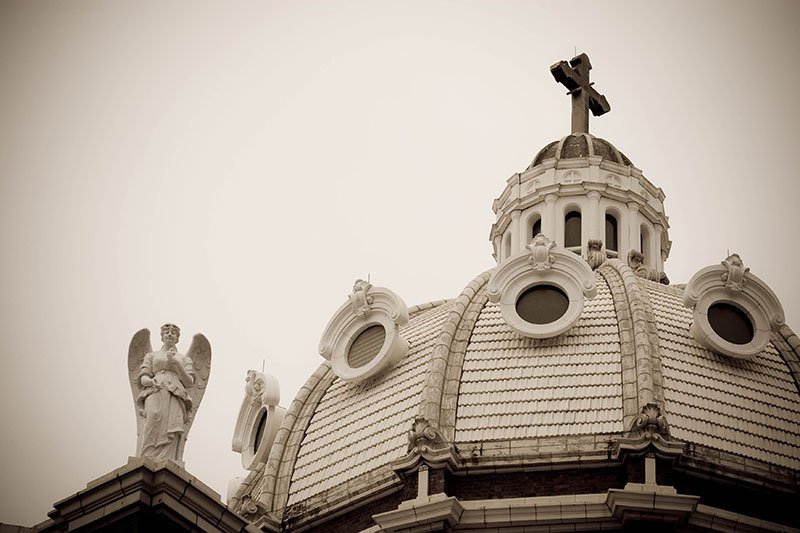The lateral stained glass window opposite to St. Francis Assisi receiving the stigmata depicts Virgin Mary entrusting the child Jesus to St. Stanislaus Kostka.
St. Stanislaus was born on October 28, 1550 in Rostkowo, Poland. He was the second of seven children: his father, Jan Kostka, was a local governor and senator for the Kingdom of Poland; his mother, Małgorzata (Margaret) Kryska, was sister to a Polish duke.
Early on God planted in the heart of Stanislaus spiritual desires for Christian service, yet his father had other plans. When Stanislaus was 14, his father sent him and his older brother Paul to Vienna to a new Jesuit college for the nobility, lodging them in the house of a Lutheran.
In Vienna Stanislaus applied himself to his studies and to his life of prayer, with daily Mass and Rosary. He also developed a deep devotion to St. Barbara, reading how she would grant, those who invoked her, the grace of receiving Holy Communion before they die. His older brother began calling him names, such as “the Jesuit.” Stanislaus transcended his brother’s meanness with kindness: “I will live in a way that I know pleases God, whether or not it pleases my brother.” When Paul tried to lure him into his worldly ways, Stanislaus didn’t succumb: “I was born for a higher end.”
In December 1565 (he was 15 years old) he became ill and thought he was going to die. He asked to receive Communion but his brother didn’t think his illness was that serious; moreover his Lutheran landlord wouldn’t permit a priest to come to the house. So Stanislaus invoke St. Barbara. She appeared to him with two angels who brought him Holy Communion. Shortly afterwards the Virgin Mary and Child appeared to him and allowed him to embrace the Child Jesus—this vision is portrayed in our stained glass window. Our Lady restored his health and encouraged him to become a Jesuit.
The superior wouldn’t allow him to join the Jesuits in Vienna without his parents’ consent. Knowing their opposition, Stanislaus consulted God, his confessor, and then decided to go to Dillingen. Paul pursued him but God’s designs protected Stanislaus, keeping Paul from catching him. In Dillingen the provincial, St. Peter Canisius, S.J., thought he was still too close to home, so he sent Stanislaus to Rome. It took him a month to travel the 600+ miles on foot, begging for food along the way. In Rome he knelt before St. Francis Borgia, the General of the Society of Jesus, to beg to become a novice and he was finally accepted. Soon a threatening letter from his father arrived, demanding his immediate return or suffer his disfavor, chains, and the dungeon. Weeping for his father’s blindness, Stanislaus remain firm. He observed all the rules of discipline carefully, treating everyone with respect, charity and humility.
On August 1st, 1568, sensing that he would soon die, Stanislaus wrote a letter to the Virgin Mary requesting to go to heaven on the 15th, the feast of her Assumption into heaven. Then on the 10th he became ill. On the 14th, he told the Jesuit medic that he would die the next day. The medic scoffed: “you’re not that sick!” Yet towards evening he got worse and received Holy Communion and the Sacrament of the Sick. Fellow novices accompanied him and heard him pray: “My heart is ready, O God, my heart is ready!” At 3:00 am his face lit up and he told those around him that Our Lady and her angels and saints had come to take him to heaven. Then he died. It was August 15. He was only 17 years old.
He was beatified in 1605 and canonized in 1726, and we celebrate his feast day on November 13. He is patron of Poland and many religious orders name him protector of their novices. St. Stanislaus Kostka Parish was established for Polish immigrants in 1867 and is still considered the mother church of the Polish parishes in Chicago.



